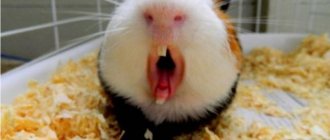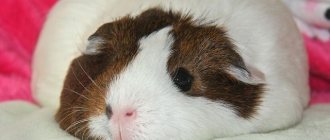Guinea pig and hamster are interesting and inquisitive animals. Both pets will definitely bring joy and fun to your home and will not let you get bored. The choice of a pet depends entirely on you: on your financial capabilities, on the available time for care, on the “requirements” for the pet, etc. Below you can get acquainted with the characteristics of each animal and the fundamental differences between them, which will help you make the right decision.
Guinea pigs are very friendly, while hamsters have an independent character
Who is better: a guinea pig or a hamster - the pros and cons of animals
Both animals - a guinea pig and a hamster - are playful and nimble animals that can create a cheerful and cozy atmosphere in the house. To make a choice, you should take into account the pet’s temperament, as well as the characteristics of care and maintenance.
What's good about a guinea pig?
Guinea pigs are easy to care for and maintain, as well as quick adaptation. The main advantages of these animals include:
- unpretentiousness in keeping and ease of caring for the pet (the main thing is to feed the animal and clean its cage);
- training opportunity;
- absolute absence of aggression ( pigs never bite or scratch their owners . By nature they are quite cowardly animals, so even for the purpose of self-defense they will not show aggression, but will try to squeeze themselves into a ball and hide);
getting along with other pets (pigs are very friendly, they quickly find contact with both other rodents and larger pets: cats, dogs)
- the possibility of keeping guinea pigs in same-sex pairs ( these fluffies are not inclined to show aggression towards their brothers, they do not have the instinct to fight for a cage or leadership , so two females or two males will get along well in one cage);
- love of affection and tenderness (these furry animals simply adore being stroked and scratched; they express their pleasure with the help of various touching sounds);
- talkativeness ( you simply cannot forget that your pet needs to be fed. A vocal pig will definitely remind you of itself with various interesting sounds when it wants to eat).
Cons of Guinea Pigs
- animals need constant attention and painfully endure loneliness (in the absence of attention and affection from the owner, they will become depressed, become lethargic, immobile and even lose their appetite);
- strong odor (the waste products of guinea pigs (in particular urine) have a fairly strong and specific odor, so the cage must be cleaned regularly).
What's good about a hamster
The hamster is an active animal that can create real circus performances at home. The main advantages of a small pet are:
- independence from communication with the owner (hamsters do not require much attention; they are used to living on their own);
compact dimensions (the size of the animal, and therefore the cage required for it, will not particularly crowd you out even in a small room)
- unpretentiousness in care (feeding and cleaning are two basic rules for caring for a hamster);
- affordable price ( hamsters are one of the most financially affordable pets. On average, a hamster can be purchased for 100-300 rubles without any problems, and due to their fast and high fertility, there is a high probability that you will get a furry baby for free).
Cons of hamsters
- waywardness (hamsters have a rather finicky character. If something is done not according to their wishes, these little fluffies can easily bite);
- solitary animals (this applies to both their isolated attitude towards the owner and their reluctance to have neighbors in their cage. The life of a hamster is built on the principle of “one cage - one hamster”; attempts to change this principle are unlikely to be successful. The animal will defend its territory, between neighboring pets will constantly fight.In addition, hamsters will be more aggressive towards the owner due to the general tense atmosphere).
Guinea pigs are much larger than hamsters
Advantages and disadvantages
Each of the pet rodents has its pros and cons.
Did you know? One of the smallest hamsters bred at home is considered to be the Roborovsky hamster, weighing up to 30 g and no more than 5 cm long. But there are no dwarf guinea pigs. They usually reach 1.5 kg, and in Latin America the meat breed Queenie is raised, reaching up to 4 kg.
A guinea pig has the following advantages:
- she is trainable and can learn a few simple tricks;
- peaceful and friendly character;
- get along with other animals (cats, dogs, rabbits);
- makes pleasant interesting sounds;
- lives longer;
- aesthetically cute look;
- the animal loves communication, feels good in your arms, lets you stroke its soft fur, and he likes it.
The disadvantages include the following qualities:
- They do not tolerate loneliness well. If an animal is given little attention, it begins to suffer, so they often keep two same-sex individuals in a cage. Such a pair will not be bored, and such groups of animals live longer.
- A cage for this larger rodent will take up more space than for a hamster.
- More money is spent on bedding, which must be changed frequently.
- Long-haired breeds require more careful grooming.
We recommend learning how to breed guinea pigs at home.
Benefits of hamsters:
- do not require communication and increased attention, feel great alone;
- small cell sizes;
- he does not need to be walked, he splashes out his activity in mazes and a wheel, and at the same time it is very interesting to watch him;
- can go to the toilet in a certain corner of the cage;
- they are cheap.
The disadvantages of a hamster are as follows:
- He does not tolerate neighbors. Each individual needs a separate cage.
- Can show aggression towards the owner if something is not to their liking.
- If this rodent gets out of the cage, it can damage the furniture.
- It is not advisable to keep a cage with this small rodent in the sleeping area due to noise at night.
Also find out if you can bathe your guinea pig.
What is the difference between a hamster and a guinea pig?
Despite belonging to the same order and almost equally popular for home breeding, these animals have a number of fundamental differences:
- size is the first difference that immediately catches your eye. Compared even to the Syrian hamster (the largest breed of domestic hamster), the guinea pig looks much larger ;
- lifestyle is the most important difference and often plays a decisive role when choosing a pet. The fact is that hamsters are nocturnal inhabitants, so you can only observe their active period of life in the late evening or at night, since small rodents sleep most of the day. Guinea pigs are more active during the day and rest at night . This is not to say that pigs sleep all night. Their sleeping style is very interesting - due to their increased fearfulness, pigs sleep for 10-15 minutes several times a day;
Nutrition - there is a difference both in the amount of food consumed and in the diet itself. A hamster needs much less food than a pig. You should feed him once a day, in the late afternoon, and regularly pamper him with cheese, lettuce leaves, meat or slices of bananas. Unlike hamsters, guinea pigs should not be given meat, cheese or potatoes. The pig should be given food 2 times a day - morning and evening. The main delicacy for pigs is fresh cucumber, sweet pepper and apple. A general rule for both rodents: there should be branches of fruit trees in the cage so that the pets can grind down their teeth
- life expectancy - rodents have a significant difference in this criterion. Guinea pigs live much longer: their average lifespan with proper care is 5-7 years. Hamsters rarely live past three years;
- learning ability - in this case, guinea pigs have an advantage. These animals are easy to train, so if desired, pigs can be trained to perform tricks of varying degrees of complexity. A trained pig can recognize its owner, follow him, roll a small ball with its muzzle, and also stand on its hind legs ;
- home - the difference is in the size of the cage, as well as its contents. A guinea pig needs a spacious cage in which it can lead an active lifestyle, since inactivity often leads to obesity. The cage should have a house or hammock in which the pig can sleep or hide. It is not necessary for a hamster to purchase a spacious cage; the main condition is the presence of various labyrinths and a running wheel in the cage. Like a guinea pig, a hamster needs a place to sleep and hide. It is important that the hamster’s house needs to be cleaned regularly, because this thrifty animal tends to carry and hide food that can quickly spoil;
- walk: you should not let your hamster out for a walk around the house - he will definitely be attracted to some hard-to-reach place that will vaguely remind him of a hole. Getting the baby out of there will be a real challenge, so you need to let the hamster go for a walk only in a special ball, which can be purchased at a pet store. With a guinea pig, things are much simpler - you can and even need to let him go for a walk . Catching it will not be difficult due to its large size and slowness.
Children under 3 years old should not have a pet at all.
Making a choice
When choosing a pet, you should keep in mind that pigs live longer. The average life expectancy of an animal is six years - provided that the owner takes good care of the pet. Hamsters barely reach three years of age. To prevent your child from getting upset so often, it is better to get a guinea pig. But still, you can’t focus only on lifespan. It is important to consider the pet's character and other factors.
Character and training
Guinea pigs are friendly, sociable, calm animals with a kind and easy-going character. They can easily live in the neighborhood with other pets - cats and dogs. Moreover, they are able to make friends with such neighbors and spend time with them together, without any conflicts or misunderstandings.
Pigs are very affectionate and loyal. They like to cuddle with their beloved owner - they are very willing to go into his arms and allow them to scratch their fur. When the owner comes into the pet's field of vision, it perks up and shows joy, making sounds similar to a whistle.
Aggression in character and behavior in pigs is completely absent. They never attack, even in self-defense; their method of defense is to hide away and quietly wait out the danger.
If the owner wants to train a pet, teaching the animal to perform various tricks is not difficult. The rodent is easy to train, a few trainings - and it will perform successfully, delighting both children and adults with its abilities. A pig can be taught:
- follow on the heels of the owner;
- rise on hind legs;
- roll the ball, pushing it forward with its face, etc.
If you compare who is smarter - a hamster or a guinea pig, the latter will win. Hamsters are intelligent, but stubborn. Assessing their mental abilities is problematic - they are almost impossible to train.
Hamsters of many breeds are characterized as aggressive fighters. However, if the owner takes certain precautions when interacting with the pet, he can avoid personal acquaintance with these qualities of the rodent. You shouldn’t disturb, much less touch, your fluffy when he’s sleeping. When frightened, a sleepy animal may bite.
Communication with a hamster is completely different from contact with a pig. The small rodent can hardly be called tame. He doesn't like hugs, the most he will allow is to stroke himself a few times. If a child does not count on a pet as a playmate and is not prone to prolonged squeezing of a fluffy animal, a hamster is ideal for a child. A pig with such an owner will become sad and melancholy.
With the right approach to a wayward pet, the owner may never discover the negative sides of his character and receive only positive things from the animal.
Lifestyle
The guinea pig's activity times coincide for the most part with the human daily routine. The animal conducts its main activity during the day. In the evening, his activity decreases and at night he sleeps peacefully, without disturbing his owner with his fuss.
The hamster differs from the guinea pig in that its activity period occurs at night. During the day, the pet sleeps and gains strength. And in the dark it is impossible to calm down the animal - it is during these hours that the peak of its activity and vigor comes. From the evening until the morning, the rodent fidgets, rustles, rustles, gnaws, runs, etc.
Therefore, if the owner wants to get some sleep, the cage with the hamster should be placed away from the sleeping area (or moved overnight). Otherwise, instead of sleeping at night, you will have to listen to the sounds of your pet’s vigorous activity.
Care
Pigs are quite easy to care for. A 6-year-old child can carry out the necessary daily care independently. But it is difficult for children of preschool age (from three years old) to cope with such responsibilities, so until the child grows up, an adult needs to help him take care of the pet.
In addition, due to his age, it is difficult for the little owner to understand what is possible and what is not in handling the animal, so an adult will need to monitor the baby so that when playing with the pet, he does not go beyond what is permissible. Having suffered morally or physically, the animal may stop trusting its owner.
Hamsters, like pigs, do not require special care. Even children can take care of such a pet, but it is still better to give a rodent to a school-age child with a calm character. Such an owner will be able to simply observe the animal and will not force communication on it, which means there will be no conflicts.
Cell
A guinea pig needs space, so its cage should be of such a size that the animal can move around freely, but also run, play, etc. Physical activity is a prerequisite for a pet’s full life. If this is not done, the animal will become obese, its legs will become weak, which, of course, will negatively affect its general health.
The cage is placed in a quiet, warm room without drafts (otherwise there is a high risk that the animal will catch a cold). Your pet should not have access to wires, cables, etc. A domesticated rodent cannot resist its nature and will definitely try everything it comes across.
It is important to place a separate house in the pig’s cage, where the animal can retire - sleep, hide, etc.
The cage with the hamster is placed in a room with a calm environment, away from heating devices, direct sunlight and drafts. A medium-sized cage is suitable for a rodent. Inside, like a pig, there should be a house for privacy and relaxation. The hamster's home (including the house) needs to be cleaned periodically - the thrifty animal will definitely stockpile food that will gradually spoil.
Nutrition
Pigs are undemanding when it comes to food. They love greens, grains and grains, vegetables and fruits. The best greens for animals:
- grass;
- dandelion leaves;
- parsley;
- salad;
- dill;
- spinach.
As for the fruit and vegetable menu, it is better to include such fresh fruits as:
- apple;
- peach;
- strawberry;
- carrot;
- cucumber;
- pepper (sweet only).
For pigs, the consumption of potatoes, meat and cheese is prohibited. The same cannot be said about hamsters. They can sometimes be treated to these products. The basis of a hamster’s diet should be:
- hard food;
- vegetables and fruits.
Feed the little fluffy in the evening. The bowl is filled with food once a day. The daily diet should include grains and a tasty treat in the form of lettuce, carrot pieces or banana.
It is important to ensure that there are no prohibited foods on your pet’s menu.
Should I buy a guinea pig or a hamster for my child?
These pet rodents are living sources of fun and happiness for both adults and children. If you want to get a pet for a child, you need to take into account the age and character of the future owner.
It is better for children under three years old not to have pets at all, because this is not yet the most conscious age of a child, let the kids grow up a little.
Guinea pigs are perfect for children aged three years and older. These pets get along well with children and are friendly and playful. The absolute absence of aggression is also important to consider, because young children do not always know the limits and limits when playing with pets, to which a hamster, for example, can respond with a sharp bite. But older children can already choose a hamster as a pet.
He will become a good friend for schoolchildren. Do you have a small child in the house?
The choice of a pet animal also depends on the purpose of its establishment. If your child wants to watch the animal and its antics, then a hamster is an ideal option. This little fluffy, running in a wheel and through its labyrinths, can stage real circus performances. If a child wants a tame animal that can be constantly squeezed and stroked, then it is better to opt for a guinea pig. They are very social, so even excessive attention will only be a joy for them.
Another point to consider when choosing a pet for your child is the possibility that family members may be allergic to wool. If someone in the family has it, then it is better to forget about the pet hamster. But the pig is worth considering, since there are hypoallergenic breeds of these rodents - hairless skinny pigs.
Who is better to have for a child?
Every child benefits from interacting with animals. He learns to look after his “younger brothers,” which develops in him the ability to take care of someone, to be careful, and to empathize. For a child over three years old, it is better to get a guinea pig. She is absolutely non-aggressive and friendly, she likes to be petted and communicated. But the hamster does not like unnecessary attention to itself. Insatiable children's interest often causes aggression in the animal, and it can bite.
It should be understood that both rodents are quite fragile animals, and a fall, even from a child’s height, can lead to bad consequences. Hamsters suffer most often when interacting with children. Small children do not yet have much control over their movements and can not only drop, but also squeeze a small rodent too much. Therefore, it is better to have them if the child is content with observing the funny behavior of this animal and does not often try to pick it up and squeeze it.
Did you know? A hamster's cheek pouches can hold an amount of food equal to a fifth of its weight.
If a child of any age loves to cuddle and pet animals, then it is better for him to get a guinea pig. When you suspect that your interest in animals will not last long, it is recommended to choose a hamster. But it should be taken into account that it is recommended to get this complex rodent no earlier than 6 years of age. The student will already understand how to handle a hamster.
What's good about a hamster
Hamsters are smaller in size and live less than guinea pigs. The Syrian hamster has a body length of up to 15 centimeters and a weight of 100-150 grams. Despite the fact that this is the largest species among domestic hamsters. Life expectancy is 2-3.5 years, depending on care.
These animals are loners. One cage - one pet. Even a male and a female cannot be housed together. To reproduce, the female is placed with the male only for the mating period. If you leave two animals together, there will be a fight with serious consequences.
The cage should measure 60 by 40 at a minimum. Moreover, it is the area that is important for them, and not the number of floors. These are very active nocturnal creatures that sleep during the day. The cage must have a running wheel. On it the animal will run several kilometers every day.
The Syrian hamster can be trained and accustomed to its name. This is not difficult to do. But you need to start from childhood, an adult is difficult to train and can even bite, of course, if it is not accustomed to handling. Most often, people choose to buy a Djungarian or Syrian hamster.
There are many types of hamsters, there are even 4-6 cm in size. They all have not only different sizes, weights, gluttony, but also characters. If one species is friendly, then you cannot approach another without gloves.
Results . It doesn't matter if it's a hamster or a guinea pig, they all need care. We are responsible for those we have tamed. Proper nutrition will prolong the life of both. Whoever you choose, before purchasing, study the character of the animal in order to avoid incidents and troubles. Now you know how they differ.
Rules for caring for hamsters and other rodents
How to care for a cage
- The cage needs to be cleaned regularly. It’s better to do this every day, but if your animal is neat, it’s enough to clean the cage once a week. Leftover food and other dirt can cause serious illness in your pet.
- Before cleaning the cage, the animal needs to be transplanted somewhere, for example, into a jar or box.
- Twice a month, the animal’s home must be thoroughly cleaned. The cage needs to be doused with boiling water several times and washed with baby soap. The feeder, drinker, wheel and ladder also need to be thoroughly rinsed with hot water.
Keeping hamsters and communicating with them
Of course, it’s not easy for an animal to immediately get used to a new place. He needs about 3-5 days to get comfortable in his new house. For the first two days, do not disturb the animal, but leave it in silence longer. After this, you can begin to get acquainted with the new inhabitant, but this must be done very politely. To begin, quietly approach the cage and try to talk to him. Don't raise your voice, speak in a normal and natural voice. You can say, for example: “Hello, my name is ..., and I’ll call you ..., how are you living with me?” If the animal does not react to you in any way and is hiding from you, then try quietly knocking on the door - the animal will definitely notice you. After another two days, try to briefly put your hand into the cage and if the animal is not afraid of you, then this means that it has begun to recognize you. In general, try to talk to your pet as often as possible, pick it up and pet it.
Don’t think that if an animal is dumb and doesn’t say anything, then it doesn’t understand anything. In fact, rodents, especially rats, are very smart animals and understand everything perfectly and give preference only to the person who takes care of them.
How to care for your pet to avoid unpleasant odor
Potential breeders of these furry animals, along with the question of whether guinea pigs stink, should also be interested in the question of how to properly care for their animals in order to avoid an unpleasant odor. So, the basic rules of care:
- Correctly selected cell size. A larger home will stay cleaner longer. The size of the cage should allow the animal to allocate a separate corner where it will relieve its needs.
Who smells more, the female or the male?
And yet, like any animal, guinea pigs are also not without their natural smell. Many people wonder: who is better to choose, a female or a male? Does a male guinea pig stink? Or does the female smell more?
Of course, differences by gender determine various physiological characteristics, including the emitted odor. Males, when excited, courting a female or marking, emit a pungent odor that does not depend on the cleanliness of the cell. Each person relates to this smell differently. Many owners note that it goes away quickly and is not that strong. However, for some it is still quite unpleasant.
The female may begin to smell after giving birth due to hormonal changes. However, this phenomenon is transitory and for owners who love their pet, this is not a disaster.
The pig will not run away from an open enclosure
The pet can be placed in an open enclosure, and it will not escape from it. However, you should not do this if there is another animal living in the apartment that may be aggressive towards the guinea pig.
Such a pet will not cause problems for its owner; there is nothing difficult in caring for it. You just need to make sure that the animal always has the necessary food, clean drinking water, fresh hay and order in the cage.
- Author: Elena Romanenko
Rate this article:
- 5
- 4
- 3
- 2
- 1
(1 vote, average: 5 out of 5)
Share with your friends!











